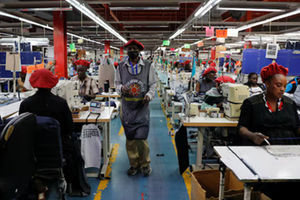Prime
Machinga Complex: Will the billions in investment ever be recouped?

Machinga Complex in Dar es Salaam. PHOTO | COURTESY
What you need to know:
- The Machinga Complex was constructed as a solution to remove the thousands of informal sector traders carrying out their businesses on the streets; and give them somewhere decent to carry out their businesses, and at the same time keep the streets free thus beautifying the city.
The Machinga Complex, a rambling two buildings five storey structure along Lindi Street in the heart of Dar es Salaam was again recently in the news. While presenting his Report to Her Excellency the President, the Controller and Auditor General (CAG) said that a loan of Sh15.9 billion from the National Social Security Fund (NSSF) in 2007 to build the Complex has hardly been paid back.
While the Principal and interest had accumulated to Sh27.6 billion, only Sh80.0 million has been paid back by the Dar es Salaam City Council (DCC) since 2009. As the Report covers the period to 2023/24, the situation may have gotten worse.
Furthermore, the CAG pointed at anomalies about the contract for the loan between the DCC and NSSF; that there was no guarantee from the government and that there was no certificate of title deposited as collateral for the loan.
If you are receiving or expect to receive a pension from the NSSF, such news can only send chills down your spine. How will such an amount be paid back to the NSSF?
The Machinga Complex was constructed as a solution to remove the thousands of informal sector traders carrying out their businesses on the streets; and give them somewhere decent to carry out their businesses, and at the same time keep the streets free thus beautifying the city.
Yet the traders seem to have shunned the Complex ever since it was opened in 2009, preferring instead to continue operating in nearby streets. Experts have been scratching their heads as to what went wrong. Designed to take in over 4,000 traders, the complex remains largely under-utilized and is showing signs of deterioration.
A number of observers attribute the low occupancy rate to design shortcomings, for example the small size of the stalls; lack of parking space in an area which is very busy and congested and absence of lifts, given that the structure is five storeys high.
The location of the Complex was pointed out as not being ideal, much as it is in the city centre. It is off the main traffic orientation of pedestrians who are the potential buyers of the goods traded on the streets. It is also off the main bus routes and terminals.
It has also been argued that the design and location of the Complex did not take into considerations the preference of traders who prefer the street, where they can engage directly with the customers, to concrete structures, where customers have to struggle to find them. The few who venture to trade in the Complex soon found that they did not have customers, and that those who remained on the streets were doing robust business.
Thus, while the Complex stands largely empty, brisk trading is going on, on the streets in its vicinity.
The effective demand from the street traders was therefore assumed. Indeed, some studies have pointed out that traders were never consulted in the whole process of designing, locating, constructing and pricing of the Complex.
Real estate experts argue that the Complex did not have a management plan which would involve a calculated tenant mix, with anchor tenants attracting other smaller tenants. However, here it could be argued that if indeed there was demand for such commercial space, this demand would have shown itself, and the Complex owners wouldn’t have to struggle to get tenants.
The owners of the Complex thought they were in a suppliers’ market where anything produced goes. It was assumed that the street traders would happily pay the Sh2,000 per day (Sh60,000, a month) rental for the stalls. From the total collection there would be funds to administer and manage the Complex and pay back the loan to NSSF. All this has come to literally nothing.
With hind sight, it can be argued that Machinga Complex types of buildings are not very successful in removing traders from streets; or in running themselves commercially. In the 1990s, under the National Income Generation Programme (NIGP) two markets: Temeke Stereo and Makumbusho were constructed in Dar es Salaam, aimed at getting traders off the streets. They did not succeed in that respect. Lessons should have been drawn from these.
Getting traders off the streets has failed time and again since it involves a complex system of regulating city life, which authorities are finding difficult to do. As a result a lot of activities that should be regulated, are not.
Meanwhile, the pensioners’ funds lay down the drain in white elephant investments over which they were not consulted; nor do they have a say. Given that there is no government guarantee, or title over land, it is possible that NSSF has no fallback position.





